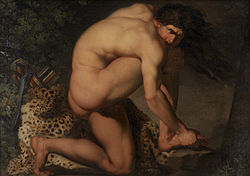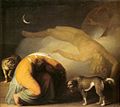Nicolai Abildgaard
Nicolai Abraham Abildgaard | |
|---|---|
Royal Danish Academy of Art | |
| Known for | Painting |
Nicolai Abraham Abildgaard (11 September 1743 – 4 June 1809)
Biography
Nicolai Abraham Abildgaard was born in Copenhagen, Denmark, as the son of Anne Margrethe (née Bastholm) and Søren Abildgaard, a noted antiquarian draughtsman.[1][3]
Abildgaard was trained by a
Student travels

Although artists of that time usually journeyed to Paris for further studies, Abildgaard chose to travel to
In the company of
An academic and artistic career
In 1778, soon after joining the Academy, he was appointed to a professorship. He taught mythology and anatomy in addition to painting of the neoclassical style. Beyond his position at the Academy, he was very productive as an artist from 1777 to 1794. He produced not only monumental works, but also smaller pieces such as vignettes and illustrations. He designed Old Norse costumes. He illustrated the works of Socrates and Ossian. Additionally he did some sculpting, etching, and authoring. He was interested in all manners of mythological, biblical, and literary allusion.[6]
He taught some famous painters, including

As royal
He made a failed attempt to be elected to the post of Academy Director in 1787 and was unanimously elected to the post two years later, serving as director during the period 1789–1791.[1] He had the reputation for being a tyrant and for taking as many of the academy's monumental assignments as possible for himself.[7]
Abilgaard was also known as a religious freethinker and an advocate of political reform. In spite of his service to (and in his artwork the glorification of) the government, he was hardly a great supporter of the monarchy or of the state church. He supported the emancipation of the farmers and participated in the collection of monies for the Freedom Monument (Frihedsstøtten) in 1792. He contributed a design for the monument, as well as for two of the reliefs at its base. He got drawn into controversies at the end of the 18th century because of his provocative statements and satirical drawings. He was inspired by the French Revolution, and in 1789–1790 he tried to incorporate these revolutionary ideals into the Knights' Room at Christiansborg Palace. However, the King rejected his designs.[7]
His showdowns with the establishment culminated in 1794, when his allegorical painting "Jupiter Weighs the Fate of Mankind" (Jupiter vejer menneskenes skæbne) was exhibited at the Salon. He was politically isolated and cut out of the public debate by censors.
At the start of the 19th century, his interest in painting was restored when he painted four scenes from Terence's comedy Andria. In 1804 he received a commission for a series of paintings for the throne room in the new palace, but disagreements between the artist and the crown prince put a halt to this project. He continued, however, to provide the court with designs for furniture and room decorations.
He was once again selected to serve as the Academy's director from 1801 until his death.
Gallery
-
Richard III, oil on canvas, 1787.
-
Danish Design Museum.
-
Culmin's Ghost Appears to his Mother, oil on canvas, 1794.
Personal life
Abildgaard married Anna Marie "Nancy" Christiane Oxholm (1762–1822) in 1781. She gave birth to his son Marcus Aurelius the same year. However, he lived only to 4 years of age.
When Abildgaard found out his wife was unfaithful with
Legacy
Though Nicolai Abildgaard won immense fame in his own generation and helped lead the way to the period of art known as the
See also
- Art of Denmark
References
- ^ ISBN 978-1-59339-837-8.
- ^ "Nicolai Abraham Abildgaard". Salmonsens konversationsleksikon. Archived from the original on 3 April 2019. Retrieved 1 April 2019.
- ^ Katrine Kalleklev. "Søren Abildgaard". Store norske leksikon. Retrieved 1 April 2019.
- ^ Weilbach, P. (1877). Dansk Konstnerlexikon, indeholdende korte Levnedstegnelser over Konstnere, som indtil Udgangen af 1876 have levet ... i Danmark eller den danske Stat (in Danish). Höst og Sön. p. 9. Archived from the original on 3 June 2021. Retrieved 3 June 2021.
- ^ a b Jul. Lange. "Abildgaard, Nicolai Abraham, 1743–1809". Dansk biografisk Lexikon. Archived from the original on 5 September 2019. Retrieved 1 April 2019.
- ^ a b Charlotte Christensen. "Nicolai Abildgaard". Den Store Danske, Gyldendal. Archived from the original on 4 April 2019. Retrieved 1 April 2019.
- ^ a b c Patrick Kragelund. "Nicolai Abraham Abildgaard". Kunstindeks Danmark & Weilbach Kunstnerleksikon. Archived from the original on 3 April 2019. Retrieved 1 April 2019.
- ^ "Christian VIII's Palace". The Royal Danish House. Archived from the original on 4 April 2019. Retrieved 1 April 2019.
- ^ One or more of the preceding sentences incorporates text from a publication now in the public domain: Chisholm, Hugh, ed. (1911). "Abildgaard, Nikolaj Abraham". Encyclopædia Britannica. Vol. 1 (11th ed.). Cambridge University Press. p. 63.
Other sources
- Christopher John Murray (2004). Encyclopedia of the Romantic Era, 1760–1850: A-K. Taylor & Francis. p. 1. ISBN 978-1-57958-423-8. Retrieved 31 December 2012.
- S.A. Sørensen, "Reinhard von Eppingen", i: C.F. Bricka (red.), Dansk biografisk Lexikon, København: Gyldendal 1887-1905.



